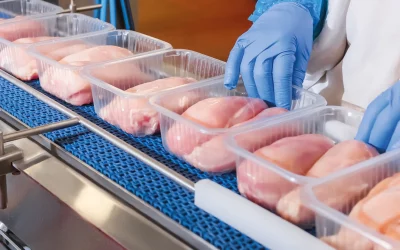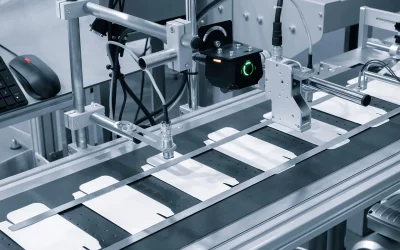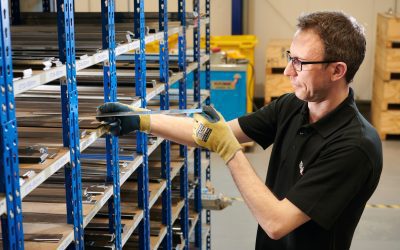The properties you should look for in medical packaging machine blades
Medical devices, and by extension their packaging, are subject to a wide variety of regulations. Medical packaging must maintain the sterility of whatever it is containing, and it must be shown to be effective throughout the product’s claimed shelf-life.
As such, your machine blades must help your packaging meet these requirements.
Compliance with ISO 11607-1:2020 and other regulations
Medical devices which are intended to be terminally sterilised (i.e. the process of sterilising a product in its final container), must be packaged in packaging which meets the standards of ISO 11607-1:2020.
ISO 11607-1:2020 is the first of two international standards written to ensure that terminally sterilised medical device packaging allows sterilisation, provides physical protection and maintains sterility to the point of use.
As the standard sets out, ‘the development and construction of packaging systems for terminally sterilised medical devices is complicated and critical to patient safety’.
The second of these standards is ISO 11607-2:2020 which sets out the validation requirements for forming, sealing and assembly processes.
Without going into too much detail, these standards set out exact requirements for the specifications of finished packaging.
As such, you need to ensure that you use machine blades which are accurate and able to produce cuts which create packaging that meets these standards.
Perfect fit with your machinery
If your machine blades are not absolutely perfectly aligned with your machinery, it’s unlikely you’ll produce medical packaging that meets the exacting standards set out above.
At MRMK we ensure that our blades fit just as well (if not better!) than OEM blades. Explore our selection of blades for medical packaging and you’ll find models which are perfectly adapted to specific machine types including ULMA, Tiromat, CFS, and GEA.
Razor sharp
As we’ll see later in this article, it’s important that your machine blades are razor sharp. Medical packaging has to be perfect, so you need to be able to achieve perfect cuts every time.
You’ll do that by buying razor sharp machine blades. Choose blades that are precision engineered from a high-quality stainless steel (420, or 440) and you can be assured that you’ve got blades that can make the sort of precision cuts which are required for medical packaging.
Reliability
In the highly-regulated world of medical device packaging, any downtime can cause profit margins to shrink (or disappear entirely).
To avoid any unplanned downtime, ensure that you select quality machine blades which are able to maintain their sharpness, resist blunting, and which can be quickly and easily replaced on set schedules.
Select machine blades with those characteristics and you’ll go a long way to improving the overall profitability of your medical packaging operations.
Now that we’ve seen which properties you should be looking for in your machine blades, let’s take a closer look at the packaging itself.
What types of materials will you be cutting?
One of the most important things to consider when selecting machine blades for your medical packaging operations, is the types of materials you’ll be expecting the blades to cut through.
Because of the multiple requirements placed upon medical packaging (sterilisation, seal integrity, shelf lifecycle), a raft of different materials tend to be used to create pouches, trays and bags that contain devices and medicines.
Paper
Paper is used extensively in today’s medical packaging. We’re not talking about any old paper, however. Because paper can generate particles when cut, thus compromising sterility, paper in medical packaging is usually impregnated with a polymer.
Whilst this solves the particle contamination issue, it does mean that machine blades must be extremely sharp in order to effectively cut through this type of paper.
Tyvek
A product of DuPont, Tyvek is marketed as an alternative to medical-grade paper.
As a High-Density Polyethylene (HDPE), Tyvek offers an effective barrier against microorganisms, yet is extremely resistant to tearing and puncturing.
As such, if you’ll be using Tyvek in your medical packaging operations you’ll need to ensure that blades such as flying knives are extremely sharp and able to resist blunting.
Aluminium
Aluminium is another material that’s commonly used in medical packaging; and, like the other materials listed on this page, presents its own challenges to machine blades.
Whilst aluminium is an effective barrier against light, oxygen, and moisture, it is vulnerable to pin holes and flex-cracking, which means that in medical packaging contexts it requires the use of protective layers.
Aluminium cannot be heat sealed by itself, and as such requires a dedicated heat seal layer if it is to be used in heat-sealed packaging.
Plastic
Whether it’s used to form trays, or combined with other materials to form packets, plastic is another material which is ubiquitous in medical packaging.
Plastics that are typically used for medical packaging include LLDPE, PP, PET, HIPS and vinyl.
If you’ll be dealing with plastic as part of your medical packaging operations, then it’s vital that you have the correct types of machine blades.
For example, you’ll want a selection of circular knives for the slitting, perforating and trimming of plastic. Cutoff blades will be useful for the bulk cutting of plastic films, whilst straight knives are useful for slitting applications.
Folding cartons
Whilst the materials listed above will help you create a SBS (sterile barrier system), which will prevent the ingress of microorganisms to the device or medicine, it’s also worth bearing in mind that many pharmaceutical companies now also recommend the use of folding cartons to provide secondary protection.
Not only do folding cartons provide additional protection, but they also serve as somewhere to place important on-pack warnings, information and instructions.
If you’re going to be using folding cartons as part of your medical packaging process, then it’s important to have appropriate blades, as well as print parts.
Medical packaging knives from MRMK
We hope you’ve found our guide to choosing the right machine blades for your medical packaging operations useful.
Explore our website to find out more about what makes MRMK’s blades different.
Explore medical packaging knives at MRMK now
Find out more about industrial packaging and machine knives on the MRMK news and insights hub…
When to Replace Your Industrial Machine Blades | What Are the Different Types of Packaging Machine Knives? | The Ultimate Guide to Blade Coatings and Their Benefits



